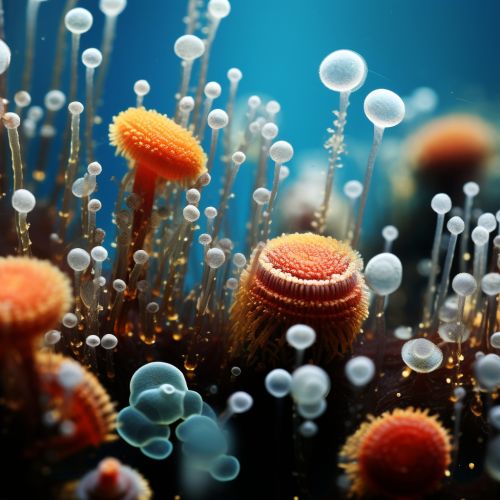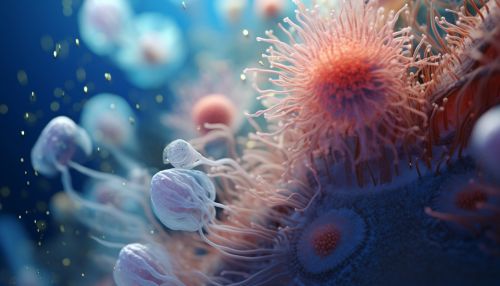Mechanisms of Microbial Biogeochemical Cycling in Marine Environments
Introduction
Microbial biogeochemical cycling in marine environments is a complex process involving the transformation and cycling of chemical substances through biological, geological, and chemical processes. It involves the interaction of microorganisms, such as bacteria, archaea, and fungi, with the physical and chemical aspects of the marine environment. These interactions result in the cycling of elements such as carbon, nitrogen, sulfur, and phosphorus, which are essential for life.
Microbial Role in Biogeochemical Cycling
Microorganisms play a crucial role in biogeochemical cycling in marine environments. They are responsible for the transformation of elements, including the conversion of inorganic compounds to organic compounds and vice versa. This process is essential for the maintenance of life in the ocean, as it ensures the availability of nutrients necessary for the survival of marine organisms.


Microorganisms are involved in various biogeochemical processes, including photosynthesis, respiration, nitrogen fixation, denitrification, and sulfur cycling. These processes contribute to the cycling of elements in the marine environment.
Photosynthesis and Respiration
Photosynthesis is a process by which microorganisms, such as cyanobacteria and algae, convert carbon dioxide and sunlight into organic compounds and oxygen. This process is a significant part of the carbon cycle in marine environments, contributing to the sequestration of carbon and the production of oxygen.
Respiration, on the other hand, involves the breakdown of organic compounds by microorganisms to produce energy, carbon dioxide, and water. This process is a crucial part of the carbon cycle, contributing to the release of carbon dioxide into the atmosphere.
Nitrogen Fixation and Denitrification
Nitrogen fixation is a process by which certain microorganisms convert atmospheric nitrogen into ammonia, a form of nitrogen that can be utilized by other organisms. This process is a critical part of the nitrogen cycle in marine environments, contributing to the availability of nitrogen for the growth of marine organisms.
Denitrification, on the other hand, involves the conversion of nitrate, a form of nitrogen, into nitrogen gas by certain microorganisms. This process is a significant part of the nitrogen cycle, contributing to the removal of excess nitrogen from marine environments.
Sulfur Cycling
Sulfur cycling involves the transformation of sulfur compounds by microorganisms. This process includes the oxidation of sulfide to sulfate by certain bacteria and the reduction of sulfate to sulfide by sulfate-reducing bacteria. Sulfur cycling is a critical part of the sulfur cycle in marine environments, contributing to the availability of sulfur for the growth of marine organisms.
Impact of Microbial Biogeochemical Cycling on Marine Environments
Microbial biogeochemical cycling has a significant impact on marine environments. It influences the availability of nutrients, the production and consumption of gases, and the overall health of marine ecosystems.
Nutrient Availability
Microbial biogeochemical cycling contributes to the availability of nutrients in marine environments. The transformation of elements by microorganisms ensures that nutrients are available in forms that can be utilized by marine organisms. This process is essential for the growth and survival of marine organisms, contributing to the productivity and biodiversity of marine ecosystems.
Gas Production and Consumption
Microbial biogeochemical cycling contributes to the production and consumption of gases in marine environments. Processes such as photosynthesis, respiration, nitrogen fixation, and denitrification result in the production and consumption of gases, including oxygen, carbon dioxide, and nitrogen gas. These processes influence the concentration of gases in the atmosphere and the ocean, impacting climate and ocean chemistry.
Health of Marine Ecosystems
Microbial biogeochemical cycling influences the health of marine ecosystems. The cycling of elements contributes to the maintenance of nutrient balance, the regulation of gas concentrations, and the detoxification of harmful substances. These processes are essential for the health and resilience of marine ecosystems, supporting the survival of marine organisms and the functioning of marine food webs.
Conclusion
Microbial biogeochemical cycling in marine environments is a complex and essential process. It involves the transformation and cycling of elements by microorganisms, contributing to the availability of nutrients, the production and consumption of gases, and the health of marine ecosystems. Understanding this process is crucial for the management and conservation of marine environments.
